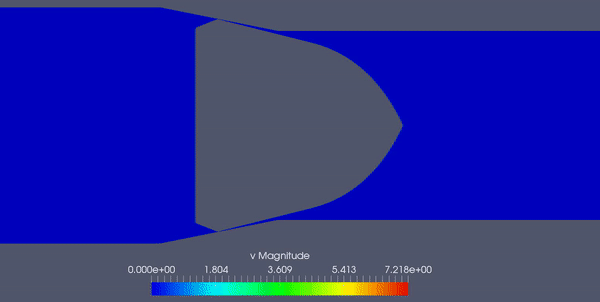Base Capabilities
The Loci-Stream CFD code is a comprehensive tool capable of efficiently solving fluid-flow and heat transfer in large scale industrial applications. The base capability includes many of the common features found in other standard CFD tools such as ANSYS-Fluent and Simcenter STAR-CCM+. These features are briefly described below. For a more detailed description of the methods used in Loci-Stream, see the Loci-Stream Technical Manual.
Generalized Unstructured Mesh Solver
It is well-known in the CFD community, that for complex geometries, which are commonly found in industrial applications, the use of structured meshes is particularly problematic from both a grid generation standpoint and a solution accuracy standpoint, since it is often extremely difficult to selectively control grid resolution in the various parts of the domain independently. In contrast to structured meshes, unstructured meshes provide a relatively convenient means of discretizing a volumetric domain, since different cell topologies (tetrahedra, pyramids, prisms and hexahedra) may be employed throughout the domain.
With unstructured meshes, the distribution of cell size and shape may be suitably taylored in a more local fashion to capture the characteristics of the flow to be found in each particlar region. Loci-Stream is a generalized unstructured mesh solver that employs face-based control volume assembly techniqes, in which convective and diffusive fluxes are assembled over the faces of the mesh, with no assumption of cell type on either side of the face. Using face-based assembly thus allows Loci-Stream to operate with a generalized cell type (no limit on the number of faces per cell).
These schemes allow for the highly-accurate simulation of compressible flows with discontinuities that meet or exceed solutions that can be achieved with density-based codes employing schemes such as HLLC and HLLE.
Incompressible and Compressible Flows
Loci-Stream employs pressure-based methods from the SIMPLE family of algorithms to provide a unified framework for the solution of both incompressible and compressible flows. Solution methods include SIMPLE, SIMPLEC and PIMPLE. The SIMPLE and SIMPLEC methods provide a robust convergence strategy for both steady and unsteady flows. The PIMPLE solution method allows for a much more efficient means of solving time-accurate unsteady flows (up to three times faster than SIMPLE or SIMPLEC).
Time-Stepping Schemes
Three time-stepping schemes are provided in Loci-Stream, first-order backward differencing (BDF), second-order backward differencing (BDF2) and Crank-Nicolson (CN). For marching to steady-state, the preferred scheme is BDF. For unsteady simulations, both BDF2 and CN can be used to significantly increase the time step over BDF while still maintaining time accuracy. The CN scheme is available as a blended BDF/CN scheme which can vary from pure BDF to pure CN using a linear weighting factor. Loci-Stream also employs a variable time-step formulation, thus allowing BDF2 simulations to maintain formal second-order accuracy even in the presence of non-constant time step.
Convection Schemes
Standard convection schemes for flows without discontinuities include the first-order upwinding (FOU) and second-order upwinding (SOU) schemes. For flows with compressible phenomena such as shock waves, expansion fans, and contact discontinuities, Loci-Stream provides state-of-the-art schemes based on the Simple Low-Dissipation AUSM (SLAU) framework.
Equations of State
Loci-Stream contains a number of options for the simulation of both ideal-gas and real-fluid mixtures. The base equation of state in Loci-Stream for compressible flow is based on Amagat's Law of additive volumes, which is applicable to mixtures that simultaneously contain both gases and liquids. Loci-Stream supports a general fluid consisting of an arbitrary number of individual species. Each species may independently be assigned as an ideal-gas or a real-fluid. Supported real-fluid options include the Peng-Robinson, SRK, stiffened-gas, Van der Waals, and Tait equations of state.
Finite-Rate Chemistry with Operator Splitting
Loci-Stream contains a very robust finite-rate chemistry capability for the simulation of combusting flows. Second-order Strang operator splitting is employed to allow large time steps for stiff combustion chemistry mechanisms. CVODE is used to integrate the ODEs in an efficient manner for the reaction substep. Reaction mechanisms that contain the standard elementary, three-body and pressure falloff reactions are completely supported.
Moving Mesh & Overset Grids
Loci-Stream supports moving meshes as well as overset meshes. The overset mesh feature utilizes hole-cutting algorithms to remove unused cells from the domain while retaining appropriate interpolation regions between the background mesh and the moving meshes. The use of multiple unstructured polyhedral overset meshes is supported.
Lagrangian Particle Tracking
Loci-Stream has a Lagrangian particle module that supports the use of discrete spherical particles for dispersed multiphase simulations. These particles have features for breakup and evaporation/boiling as well as coupling back to the eulerian solver. Supported evaporation/boiling models are simple boiling, Langmuir-Knudsen, and Abramzon-Sirigano. A simple Weber breakup model and a stochastic breakup model are available for modeling droplet breakup.



